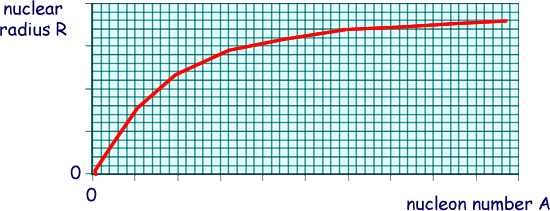Nuclear Radius
Q5.
(a) On the graph paper below sketch a graph to show how the radius, R, of a nucleus varies with its nucleon number, A.

You need to sketch a graph starting (steeply) near/at the origin and decreasing in gradient 
(1 mark)
(b) The radius of a gold-197 nucleus  is 6.87 × 10–15 m.
is 6.87 × 10–15 m.
(i) Show that the density of this nucleus is about 2.4 × 1017 kg m–3.
mass = 197 x 1.67 x 10-27 = 3.29 x 10-25 kg
= 3.29 x 10-25 kg
volume = 4/3 (πr3) = 4π x (6.87 × 10–15)3 /3  = 1.39 x 10-42 m3
= 1.39 x 10-42 m3
density = mass/volume = 2.4 × 1017 kg m-3
(2 marks)
(ii) Using the data from part b(i) calculate the radius of an aluminium-27 nucleus,  .
.
RAl3/AAl = RAu3/AAu
RAl3= RAu3AAl/AAu
RAl3= (6.87 × 10–15)3x 27/197
RAl= 3.54 x 10-15m 
(2 marks)
(c) Nuclear radii have been investigated using α particles in Rutherford scattering experiments and by using electrons in diffraction experiments.
Make comparisons between these two methods of estimating the radius of a nucleus.
For each method your answer should contain:
- the principles on which each experiment is based including a reference to an appropriate equation
- an explanation of what may limit the accuracy of each method
- a discussion of the advantages and disadvantages of each method
The quality of your written communication will be assessed in your answer.
principles
- α scattering involves coulomb or electrostatic repulsion
- electron diffraction treats the electron as a wave having a de Broglie wavelength
- some reference to an equation, for example λ = h/mv ; eV = mv2/2 ; Qq/4πεor = Eα ; sinθ = 0.61λ/R
- reference to first minimum for electron diffraction
accuracy
- α's only measure the least distance of approach, not the radius
- α's have a finite size which must be taken into account
- electrons need to have high speed/kinetic energy to have a small wavelength or wavelength comparable to nuclear diameter, the wavelength determines the resolution
- the wavelength needs to be of the same order as the nuclear diameter for significant diffraction
- requirement to have a small collision region in order to measure the scattering angle accurately
- importance in obtaining monoenergetic beams
- cannot detect alpha particles with exactly 180o scattering
- need for a thin sample to prevent multiple scattering
advantages and disadvantages
- α-particle measurements are disturbed by the nuclear recoil
- mark for α-particle measurements are disturbed by the strong nuclear force when coming close to the nucleus or electrons are not subject to the strong nuclear force.
- a second mark can be given for reference to strong nuclear force if they add electrons are leptons or alpha particles are hadrons.
- α's are scattered only by the protons and not all the nucleons that make up the nucleus
- visibility – the first minimum of the electron diffraction is often difficult to determine as it superposes on other scattering events
(6 marks)
(Total 11 marks)


